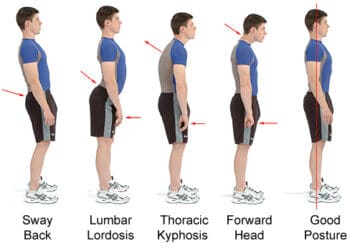To begin a discussion about posture, let’s first define what posture means. Posture is a position in which someone holds their body when standing or sitting. Most health practitioners often ignore this topic, but the roots of many pains in our bodies begin from it. In this article, we’ll discuss examples to understand what good posture looks like and why it is crucial to your health.
Good Posture
The best way to understand good posture is to feel it and to see it. If you have a mirror, place it perpendicular to the wall, such that when you put your back on the wall you can see the curve of your spine. Now, stand up straight with your back and buttocks directly against a wall. This position may feel awkward at first, but it is an excellent example of good posture.
Think about the things around us. There is a law that all objects follow, and it is that structure dictates function. A bridge, for example! When the bridge or roof of your house is built an engineer figures out angles at which reinforcements will provide support. If the angles are not correctly aligned, it makes the structure weaker; thus, a more inadequate structure will break easier. This is a straightforward concept that demonstrates how structure dictates function.
In short, your posture is the structure, and the function is how well your body performs.
Hint: if it’s causing you pain, then the function isn’t very good!
Effects of Posture
A Visual Example
Poor posture (essentially ignoring everything we discussed above) is a bad habit that we develop over our lifetime. It ends up haunting us and hurting us later in life, but at that point, you have far less control over it. Just like a poorly built building that is ready to collapse, repairing it can become difficult. We’ve all seen bad posture, and we all understand it now. Yet when it comes to our body, we ignore the consequences. Unlike a building that you can rebuild, the choices we make every day make a difference to our health and wellbeing.
How does your posture impact your body?

Here you can see a simple diagram for how your head and neck position impact the position of your torso, hips, and legs. We balance on a daily basis, so if something is out of balance, your body will compensate in a different region. By compensating in a different region, any misalignment will lead to increased forces on your body.
Calculation of Forces
Let us say your head is shifted forward in relation to your torso by only 2 cm. A typical human head weighs on average 8 pounds. Every 1 cm that the head is shifted forward, biomechanically, the forces to your upper back and neck increase by 8 pounds!
At a 2 cm shift, your head effectively weighs 24 pounds. What does that lead to overtime? It leads to a hump that starts to grow over time in the lower portion of the neck and upper back. Muscles tighten up, which causes pain in the shoulders and decreases blood flow to the head. Frequently with this scenario, tension-type headaches and migraines begin to occur. In addition, challenges such as increased weight, discs degenerate, and arthritis begins to develop.
This example is only one of the hundreds of examples of postural defects. There are many examples like this in different areas of your body.
Please take care of yourself! If left untouched, these challenges can lead to irreversible damages.
Our clinic Dr. Ibolit is equipped with special tools that allow us to measure all your postural defects and correct them. Consultation is free, be educated, take care of your kids and yourself before it is too late.
Do not wait or hesitate to call 360-737-9665.


